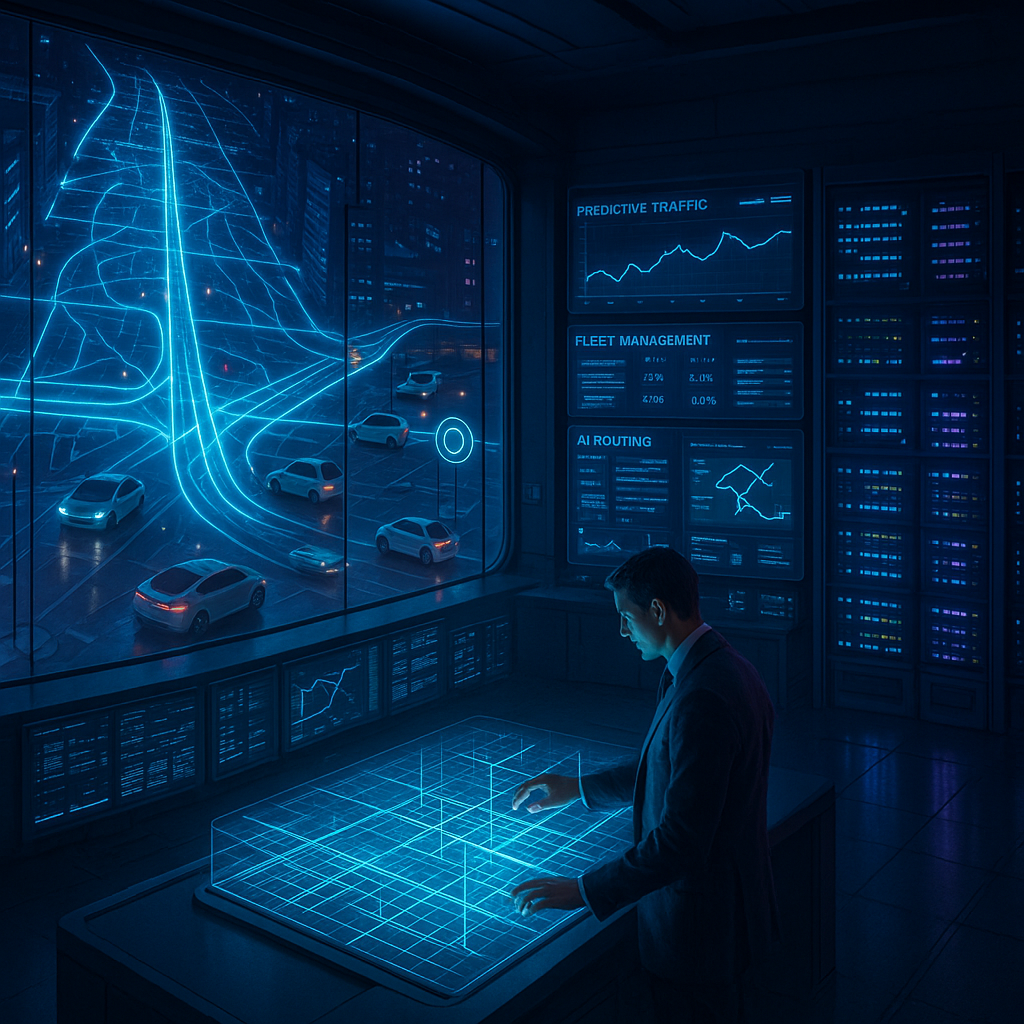Key Takeaways
- Intelligent algorithms efficiently navigate urban complexity. Transportation AI harnesses advanced machine learning and heuristic algorithms to process vast datasets, optimizing freight and passenger routes with unmatched speed and accuracy.
- Real-time data enables adaptive route optimization. By continuously analyzing live traffic feeds, weather updates, events, and demand patterns, AI systems dynamically adjust routes, minimizing delays, cutting fuel consumption, and reducing traveler frustration.
- Smart mobility platforms transform urban transit. AI-driven solutions enhance city transportation with features like demand-responsive shuttles, dynamic ride-sharing, and intelligent scheduling, offering flexible, scalable answers for increasingly intricate urban landscapes.
- Predictive maintenance increases fleet reliability. Utilizing machine learning models, transportation networks can forecast equipment failures before they happen, reducing downtime, cutting maintenance costs, and ensuring more consistent fleet performance through timely interventions.
- AI empowers equitable and accessible transit planning. Beyond enhancing efficiency, AI helps planners model community needs, prioritize underserved areas, and design routes or services that widen access to mobility for diverse populations.
- Sustainable impact through reduced emissions. AI-powered transportation systems curb idling, shorten travel distances, and help support electrified fleets, playing a pivotal role in lowering greenhouse gas emissions and improving urban air quality.
- Holistic visibility boosts supply chain performance. Integrated AI platforms enable real-time monitoring from warehouse to endpoint, securing transparency, efficiency, and responsiveness throughout complex logistics networks.
- Social impact through inclusive mobility. AI is not confined to logistics optimization. It redefines societal movement by bridging accessibility gaps, easing congestion, and creating more human-centric, inclusive transport systems.
These transformative shifts position transportation professionals to lead with both intelligence and empathy. The following sections explore the concrete technologies, strategies, and cross-industry case studies that are defining the next era of smart, adaptive mobility.
Introduction
Every city hums with billions of data points during the daily commute, yet much of that potential intelligence gets trapped in outdated infrastructure and static traffic models. Transportation AI is revolutionizing the way we navigate and manage sprawling networks. It is not merely about reducing inefficiencies through real-time routing. It’s about fundamentally reimagining how people and goods flow through the ever-shifting urban landscape.
The stakes for transportation professionals are higher than ever before. Modern algorithmic and smart platform solutions now make adaptive routing, predictive maintenance, and data-driven strategy a reality, delivering results that extend beyond operations to shape equity, sustainability, and quality of life. This is a pivotal moment to understand how advanced technologies are powering a new era of reliable, responsive, and socially conscious movement across cities and industries.
The Evolution of Transportation AI Technology
Transportation AI marks a decisive break from the static, rule-based systems of the past. Today, urban mobility platforms and logistics operations rely on sophisticated AI and machine learning approaches capable of not just processing but understanding the endless stream of real-time data generated by vehicles, infrastructure, and commuters.
Stay Sharp. Stay Ahead.
Join our Telegram Channel for exclusive content, real insights,
engage with us and other members and get access to
insider updates, early news and top insights.
 Join the Channel
Join the Channel
The DNA of modern transportation AI is multi-layered:
- Data acquisition systems pull from sensors, cameras, GPS trackers, ticketing apps, and even payment systems, creating a living map of movement patterns.
- Preprocessing modules clean, normalize, and standardize these diverse streams, turning raw data into actionable intelligence.
- At the heart, AI engines powered by deep neural networks, reinforcement learning, and other machine learning methods interpret and forecast traffic, rider demand, and asset conditions.
- Optimization engines, leveraging methods like heuristic search and constraint satisfaction, produce real-time recommendations tailored for efficiency, cost, and sustainability.
- Decision-support interfaces then convert these AI outputs into clear, actionable steps for planners, drivers, and end users across industries.
Recent advances, especially in deep learning, have transformed the ability to analyze unstructured visual and audio sensor data, unlocking new layers of insight for traffic understanding, infrastructure monitoring, and incident detection. Integration of edge computing has empowered distributed intelligence at the network’s periphery, reducing latency for critical decisions. This is invaluable whether for a highway corridor with patchy network coverage or a bustling urban intersection.
Notably, these developments are not limited to city transit. Freight, aviation, maritime shipping, and even emerging verticals like drone delivery are leveraging this stack to adapt, optimize, and revolutionize their operations.
Core Applications of AI in Transportation Route Optimization
Dynamic Traffic Management Systems
AI-driven traffic management is now visibly reshaping urban mobility. These systems leverage computer vision, predictive analytics, IoT sensors, and adaptive signal controls to direct the flow of traffic in real time. Unlike the rigid fixed-timing traffic signals of the past, AI-powered management continuously optimizes signal phasing to fit current road and weather conditions. The results are striking:
- Pittsburgh: The Surtrac adaptive traffic control system trimmed travel times by 25% and emissions by 21%.
- Singapore: GLIDE traffic platform cut peak-hour travel times by 18%.
- Melbourne: SCATS implementation saw a 40% reduction in stop-and-go behaviors on major thoroughfares.
These successes are rooted in reinforcement learning algorithms that grasp the give-and-take of congestion, queue build-up, and local route priorities. By dynamically recalibrating traffic lights, adapting to transit vehicle movements, and integrating data from emergency services, these platforms blend efficiency with public safety.
This adaptive methodology is spreading to diverse domains. In the healthcare sector, ambulance prioritization through AI-driven traffic signals improves emergency response times. In the logistics sector, freight corridors benefit from coordinated green waves or dynamic toll pricing, reducing delivery bottlenecks and fuel use.
Predictive Maintenance and Route Planning
The transformation continues in fleet and infrastructure management. Harnessing predictive analytics, AI tracks vibration profiles, engine noise, and operational telemetry to forecast maintenance needs. This shift to proactive intervention leads to:
- Thirty to fifty percent fewer instances of unplanned downtime for fleets (ranging from mass transit buses to airline fleets and cargo trains).
- Ten to forty percent reductions in vehicle service costs.
- Twenty to twenty-five percent average extension of major equipment lifespan.
- Major advances in public safety by preempting catastrophic failures across road, rail, air, and shipping networks.
AI-fueled digital twins—virtual models syncing live with real-world conditions—take this further. By simulating thousands of scenarios using historic patterns, real-time sensor data, weather forecasts, and calendar event feeds, digital twins help planners stress-test routes and choose optimal strategies. In the energy industry, for instance, these predictive models maximize the efficiency of fuel supply lines or maintenance of electric charging infrastructure.
Moving to supply chains and logistics, AI can fine-tune delivery corridors in sectors from retail and manufacturing to pharmaceuticals and food distribution, adapting to supply-chain volatility and shifting consumer behavior in near real time.
Last-Mile Delivery Optimization
The e-commerce boom has intensified the “last-mile” challenge. AI addresses this complexity with algorithms that balance delivery speed against cost, customer priority, vehicle load, and environmental impact:
- Dynamic clustering groups customer drop-off points by geographic proximity and delivery windows.
- Real-time routing adapts delivery sequences as new orders flow in, especially for groceries, pharmaceuticals, and same-day retail fulfillment.
- Load optimization maximizes asset utilization (including parcel lockers or drone carriers), while driver-behavior models improve performance and safety.
Results are immediate and scalable:
- DHL’s SMARTRUCKING platform slashed last-mile delivery costs by 15% and improved punctuality across diverse markets.
- Amazon’s system shaved 20 million annual miles from its delivery van total.
- UPS’s ORION saved more than 100 million delivery miles yearly, cutting fuel use and lowering emissions by hundreds of thousands of metric tons.
These gains extend beyond pure efficiency. Environmental sustainability is front and center, with data-driven systems routinely achieving 15-30% emissions reductions versus traditional methods. In emerging sectors like micro-mobility and drone logistics, these same principles translate to higher utilization and lower resource intensity.
Beyond the Urban Core
To further broaden the impact, fields as varied as agriculture (optimizing crop transport), mineral extraction (route planning for remote mine supply chains), and humanitarian relief (pre-positioning resources before natural disasters using AI scenario models) reveal transportation AI’s expansive reach.
Transitioning from core transportation to integrated ecosystems, we find AI is not merely optimizing, but stitching together new forms of connected and intelligent mobility.
Smart Mobility Ecosystems and Integration
Connected Vehicle Technology and Infrastructure
Modern smart mobility is built on ubiquitous connectivity. Vehicle-to-everything (V2X) protocols now transmit data between vehicles, infrastructure, and even pedestrians, using DSRC and C-V2X standards. The resulting mesh delivers game-changing solutions:
- Cooperative collision avoidance systems preempt accidents by sharing trajectory and hazard data between moving parties.
- Platooning in trucking and public transport enables precise vehicle clustering, reducing drag and improving both efficiency and safety.
- Dynamic lane management adapts road settings to live conditions, redirecting flow and opening emergency lanes on demand.
- Emergency vehicle preemption automates route clearing for ambulances and fire services.
Cities such as Columbus, Ohio (Smart City Challenge), have reported up to 70% fewer intersection crashes and 25-30% faster emergency responses by deploying AI-guided connectivity infrastructure.
Stay Sharp. Stay Ahead.
Join our Telegram Channel for exclusive content, real insights,
engage with us and other members and get access to
insider updates, early news and top insights.
 Join the Channel
Join the Channel
This interconnectedness is not just for roads; aviation runways, port terminals, and even railway switchyards now employ similar data-driven coordination. The fusion of connected vehicles, traditional infrastructure sensors, and cloud-based analytics secures a panoramic, real-time view. This enables rapid, system-wide response when disruptions or disasters arise.
Multimodal Transportation Optimization
AI’s prowess shines in orchestrating complex, multimodal journeys that blend public transit, shared mobility, bike rentals, urban walking, and personal vehicle use. Key innovations include:
- Mode choice models anticipating traveler preferences and adapting recommendations accordingly.
- Transfer optimizations shortening wait times and smoothing connections between buses, trains, ride-share, and micro-mobility.
- Capacity balancing algorithms distributing demand intelligently across all available services, reducing queueing and bottlenecks.
- Environmental impact modeling that factors in the carbon and energy costs of every route variant.
Case studies demonstrate concrete benefits:
- Helsinki’s WHIM mobility service has increased public transit use by 48% among members by offering seamless, app-guided transitions between modes.
- Vienna reduced car dependency by 21% through multimodal path-finding.
- Los Angeles’ RIITS platform trims average commutes by 17 minutes by optimizing for cross-modal transfers.
Crucially, by integrating pricing, financial constraints, and accessibility data, these platforms uncover affordable, equitable mobility paths for underserved neighborhoods. This advances social inclusion alongside raw efficiency.
Autonomous Fleet Management
Coordinating large fleets of autonomous vehicles is among AI’s most demanding challenges, blending real-time service dispatch, battery management (for electric fleets), predictive positioning, maintenance, and fare optimization. Successful deployments already hint at the enormous potential:
- Las Vegas’ autonomous shuttles deliver 23% higher vehicle utilization than their manually operated counterparts.
- Ann Arbor’s self-driving goods vehicles achieve a 42% reduction in per-delivery energy use.
- Phoenix’s autonomous taxis slash passenger wait times by 37% with predictive placement.
These systems deliver dramatic economic and sustainability benefits, often cutting fleet operating costs by more than half, and reducing maintenance downtime for public and private sector carriers across urban, airport, and even mining operations.
Similar AI-powered fleet management is revolutionizing sectors like healthcare (optimizing ambulance deployments), food logistics (coordinating temperature-sensitive deliveries in real time), and retail (synchronizing curbside pickup and in-store fulfillment with autonomous vehicles).
As these technologies scale up, the integration of AI and connectivity will require innovative approaches to algorithm design and regulatory adaptation. Managing mass transit and mobility platforms with millions of simultaneous users further elevates the need for responsible, adaptive intelligence.
Algorithmic Approaches and Technical Challenges
Emerging Machine Learning Models for Traffic and Demand Prediction
Modern transportation AI must grapple with chaotic, highly dynamic urban systems. To capture temporal and spatial dependencies, traffic and demand prediction platforms often rely on:
- Recurrent neural networks (RNNs) and Long Short-Term Memory (LSTM) models, which analyze historical and current fluctuations to forecast future trends.
- Convolutional neural networks (CNNs) for processing spatial data grids, such as road intersections and lane patterns.
- Graph neural networks (GNNs) that treat transportation routes as interconnected nodes and edges, mimicking the real-world topography of cities or logistics hubs.
In healthcare, these predictive models allocate ambulances according to probable incident hotspots. In finance, they optimize cash-in-transit routes for ATMs based on predicted withdrawal patterns. And in marketing, they help retailers adjust staffing or promotions in anticipation of localized commuter surges.
Technical challenges persist, from handling data sparsity (especially in rural settings), navigating privacy and security concerns, to scaling models for cross-border or multi-city deployment. Addressing these hurdles requires a blend of AI innovation, robust data policy, and active stakeholder collaboration across public and private sectors.
Conclusion
Transportation AI is no longer a distant promise but a critical force actively reshaping the movement of people and goods, from bustling city streets to global supply chains. By integrating real-time data acquisition, edge computing, and advanced machine learning, AI empowers decision-makers at every level to enhance efficiency, sustainability, and resilience in ways never before possible.
Crucially, the impact of transportation AI transcends cost savings and operational streamlining. It unlocks new models for equitable access, environmental stewardship, and human-centered design, redefining what it means to move through and belong to the modern city. Cross-industry adoption, from healthcare and finance to education and retail, proves these benefits are neither isolated nor fleeting.
Looking toward the future, the real challenge and opportunity will be in harnessing this intelligent infrastructure to reflect our best collective values. Cities, enterprises, and communities stand at the threshold: those who anticipate new mobility paradigms, build for inclusion, and center adaptability will drive the next era of urban life. The question is not simply how AI will transform transportation, but how we will wield its transformative power to create cities and societies that move with both intelligence and empathy. The next generation of urban mobility belongs to those who shape technology not just to optimize the system, but to elevate the human journey within it.





Leave a Reply